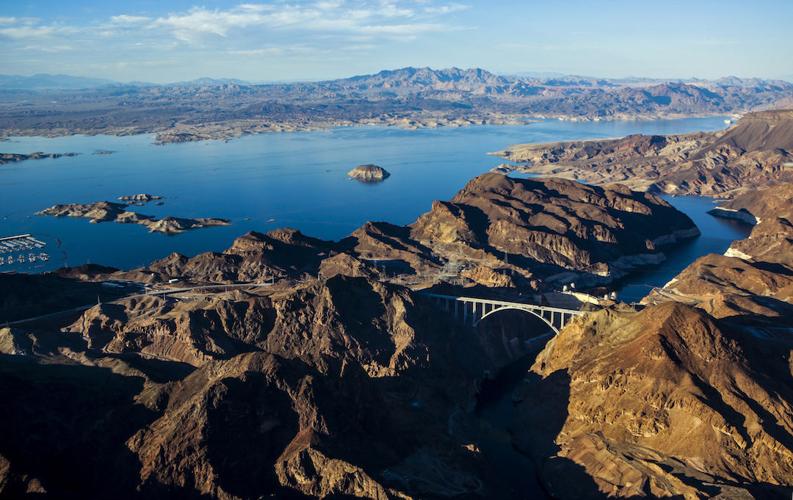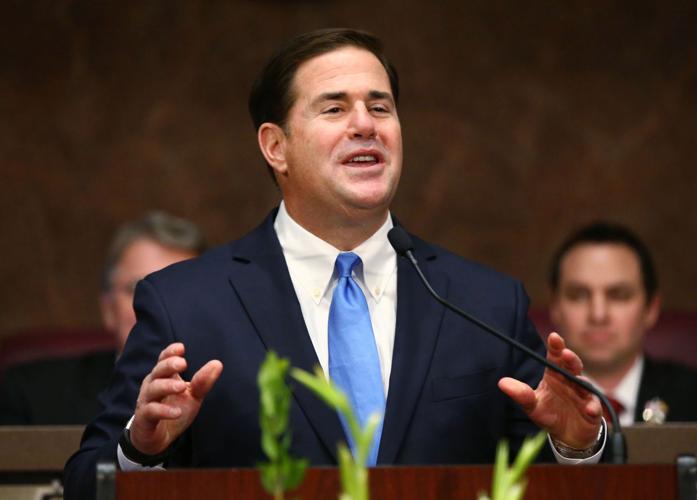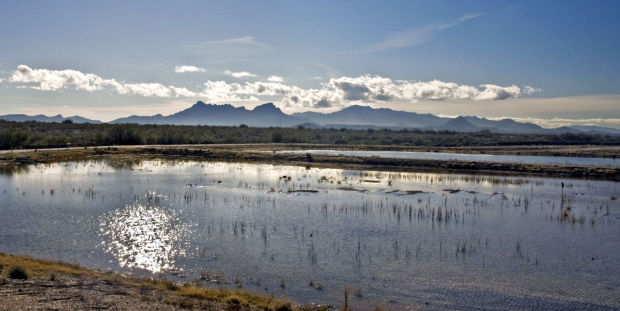For three years, federal, state and local water officials have hunted for a solution to declining water levels at Lake Mead, a key drinking-water source for Tucson, Phoenix and their suburbs.
But in the past few months, a bitter power struggle between Arizona’s two top water agencies has ground that effort to a halt.
The turf war pits the Arizona Department of Water Resources, which manages water issues statewide, against the agency operating the Central Arizona Project, the 336-mile-long canal that brings Colorado River water to Tucson and Phoenix.
The agencies are jockeying over a series of issues, many pointing to who controls the state’s most precious resource — and the population growth and jobs it can support.
But the conflict also cuts to the heart of how Colorado River water, the lifeblood of the West, will be managed.
The infighting is interfering with the agencies’ ability to come up with a fix for Lake Mead’s problems, caused by drought, climate change and chronic water overuse. It’s also raising questions about government accountability, transparency and policy.
The field on which these battles are playing out is an effort led by Gov. Doug Ducey and the Arizona Department of Water Resources to overhaul much of the state’s water management. Ducey wants to be able to assure investors that Arizona has enough water for future economic development.
Many officials say this would be the most sweeping change in state water laws since Arizona enacted the 1980 Groundwater Management Act, which ushered in an era of regulation to control excessive groundwater pumping that was draining the state’s aquifers.
Well over a dozen proposed changes in water laws have been discussed since June behind closed doors by three committees and working groups appointed by the governor.
The proceedings are considered sensitive enough that state officials have released members’ names of only one of the committees. Known as the Plenary, its 25 members represent an elite who’s who of Arizona water interests: the governor’s office, state and CAP water officials, ranchers, farmers, Indian tribes, utilities, a mining company, developers, the Arizona Chamber of Commerce, legislators and a conservationist.
Among the issues are:
- Whether the state or CAP makes the final decision to leave river water in Lake Mead that legally belongs to cities, farmers or Indian tribes, in the name of conserving it.
- Whether to establish a permanent program to compensate CAP water users who leave some of their water in Lake Mead.
- Whether Indian tribes can set up programs to leave their CAP water in Lake Mead on their own, which CAP says federal contracts don’t allow.
- Whether Colorado River water that doesn’t get used in a given year by cities, farms and tribes owning legal contracts for it should be automatically left in Mead or support future suburban growth and stored in the ground here.
- Whether the CAP should be forbidden from hiring outside lobbyists to represent it in Washington, D.C., and whether the CAP should be subjected to regular outside audits of its performance.
- Whether to require CAP officials to get the state’s approval to even negotiate with the federal government or other states over Colorado River matters.
The governor’s staff has said one purpose of this effort is to get the state’s “act together” on water, and to have officials speak “in one voice” on the issue.
Arizona Department of Water Resources Director Tom Buschatzke says the proposals have a common origin. They stem from a series of actions by CAP officials that he asserts exceeded that agency’s authority, could have harmed the state, or demonstrated an unwillingness to collaborate with local water officials in the Tucson and Phoenix areas.
“The soul of water management in Arizona” is at stake, says Kathy Ferris, a former state water director who sides with her former agency, the Arizona Department of Water Resources, and sits on the governor’s Plenary.
“Do we want our Colorado River supplies to be managed by parochial interests or do we want it managed by an agency with the outlook for the whole state?” she asked, noting that the CAP serves only three counties, Pima, Maricopa and Pinal.
CAP officials say the proposed changes require more detailed analysis, threaten their authority, eliminate government checks and balances, and could create more uncertainty for the entire river system.
They point out that their governing board members are elected and nonpartisan, while the state agency’s director is appointed by the governor.
The board is required to hold open meetings, though it also uses closed-door executive sessions to discuss key issues.
ADWR is not required to meet publicly and much of its work is done in secret, CAP supporters say. But Buschatzke points out that his boss, Ducey, is accountable to voters and to state legislators who make decisions in public.
“We were established to ensure that a lot of different issues can be talked about and good water policy can be made in the light of day,” said Karen Cesare, a Tucson board member of the Central Arizona Water Conservation District, which runs the CAP.
“We shouldn’t politicize water. If all the power goes under the executive branch, it is potentially subject to the political desires and agendas of that governor.”
Doug Miller, the CAP’s retired general counsel, told the board recently that some proposals coming from the state and governor are a huge threat to CAP’s existence.
He called the idea that Arizona should speak with one voice on water silly.
“This is a democracy, isn’t it? This isn’t the Soviet Union of the 1960s. We don’t just have one entity in the state that has the wisdom and good policy on water issues. That’s not the way that a complicated matter of technology, hydrology and law should be handled.”
Who’s taking sides
Many of the state’s water interest groups have lined up behind one agency or the other.
City utilities including Tucson Water, along with Indian tribes, are clearly allied with the state agency, ADWR.
Homebuilders and cattle growers have lined up behind the Central Arizona Groundwater Replenishment District, which is part of the CAP and buys Colorado River water and other renewable supplies for future growth.
Joe Gysel, CEO of the giant private water company Epcor, which serves tens of thousands of Arizona customers, sits on the Plenary group and supports many of the state’s proposals.
Environmental groups are split. The Nature Conservancy and the Environmental Defense Fund have representatives on the committees appointed by Ducey.
Patrick Graham, state director of Nature Conservancy in Arizona, said it’s premature for him to take a stand. Kevin Moran, the defense fund's Colorado River program director, has spoken favorably about some of these proposals in public CAP board meetings.
But Sierra Club lobbyist and Grand Canyon Chapter Director Sandy Bahr takes a plague-on-both-their houses approach, expressing particular dismay at the secrecy in this process.
Roots of the conflict
The fight erupted in January, just as it seemed an agreement over how to combat Lake Mead’s declining levels was at hand.
Through most of last year, Arizona, Nevada and California were discussing a Drought Contingency Plan that would trigger a series of escalating cutbacks in water deliveries from the Colorado River when Lake Mead dropped below certain elevations.
They wanted to prevent the lake from reaching catastrophically low levels that would threaten to curtail most water deliveries to the three states and threaten the ability of Hoover Dam at the lake to generate power.
In Arizona, authorities appeared close to agreement on a counterpart plan known as DCP-Plus, in which Arizona users by themselves would try to conserve more river water for the next three years, to put off even an early, less severe shortage as long as possible. The biggest uncertainty seemed to be how to raise $60 million to compensate Indian tribes and other users to leave some of their water in Mead.
The seeming harmony imploded over a cascading series of conflicts:
- In January, the agencies, along with cities, ranchers and homebuilders, argued over what should be done with river water that isn’t purchased in a given year by water users who have legal contracts for it.
The state and cities, including Tucson, wanted much of that water set aside for the next three years in Lake Mead. CAP officials didn’t want to be tied to a set-aside in advance, and homebuilders wanted some of the water for suburban development.
- In February, the water dispute heated up more, over an agreement signed by the U.S. Bureau of Reclamation and the Gila River Indian tribe to leave some of the tribe’s CAP water in the lake in return for federal payments.
CAP officials objected to some of the agreement terms, in part because they said it would impinge too much on their authority over water.
If the state clips CAP’s wings that way, “You will effectively see the CAWCD as a ditch operator as opposed to being the right entity in the right place to work for the future of Arizona,” Jay Johnson, general counsel of the water district, recently told its board.
- In April, conflict erupted over a 2015 claim by CAP officials in an unrelated federal lawsuit, brought by a former employee over her firing, that it has “sovereign immunity” under the U.S. Constitution’s 11th Amendment that protects it from litigation.
Arguing the case before the U.S. 9th Circuit Court of Appeals, the CAP alleged that it’s “an arm of the state,” a legal requirement for an agency to be protected from lawsuits. It’s “the single entity created by Arizona” to serve the essential function of “securing, managing and delivering more than half of Arizona’s entitlement to Colorado River water to the citizens of this state,” the district said.
The Arizona Department of Water Resources challenged the CAP’s stance in court, arguing that it’s not an arm of the state and that its functions as a three-county district are purely local. It said ADWR represents “all water users in the state of Arizona.”
In April, CAP officials played the sovereign-immunity card again, arguing that they couldn’t be sued by the Ak Chin Indian Tribe in Central Arizona in a case concerning its Colorado River water deliveries.
The governor’s office stepped in, telling CAP to back off from that claim, which CAP officials then did in court. They said they’re asserting sovereign immunity only for personnel issues and won’t use it to protect the agency against suits by water users.
But there’s no legal distinction saying CAP can protect itself from individuals’ suits and not from water users, said Ducey’s chief of staff Kirk Adams.
Dispute’s impact
on the Colorado
In the meantime, the state and CAP hit a stalemate over what to do about Lake Mead, in part because a wet year in the Upper Colorado River Basin states had significantly reduced the likelihood of river shortages for the next couple of years. Both sides agree that something still needs to be done about Mead, but the power struggle stands in the way.
Tucson City Councilman Steve Kozachik calls the state-CAP quarrel an “ego battle” when Lake Mead should be their prime focus.
“My sense is they’re arguing over how loud the music is when the bedroom is on fire,” Kozachik said.
Arizona’s inability to resolve the CAP-state conflict is a big problem for Colorado River Basin management, said John Fleck, author of a book on the river and director of the University of New Mexico’s water research center.
“The rest of us in the river basin need to know who’s in charge of Arizona’s water, or more particularly, Arizona’s Colorado River water. Arizona needs to get its act together,” Fleck said.
The closed meetings and secrecy are decried by two groups that normally disagree on everything: cattle ranchers and environmentalists.
Bahr, the director of the Sierra Club Grand Canyon Chapter, said her group has never been a fan of the CAP, but she’s more concerned about what she calls a “big power grab” by the governor’s office.
“One thing about not having one entity have all the control — it means that really bad ideas move more slowly,” she said.
“If you have one entity, especially one that doesn’t have to do things in public, they’ll be more ‘efficient,’ but what that means is we won’t even know what’s happening till it happens.”
Water policies are critical because the big issues are never about today or tomorrow, they’re always about 10, 20 or 100 years from now, said Bass Aja, the cattle growers’ government relations director.
“So the brighter the light we shine on it, usually the better the policy we will get, whether I agree with it all or not,” he said.
State water director Buschatzke defended the private meetings, saying, “We need to be able to have these conversations so people can lay their cards on the table. If there’s too much light about what’s going on,” people will feel less free to talk, he said.
As for the river and lake, Buschatzke said the governor’s committees’ proposals are intended to bring the prolonged stalemate to a close. He hopes the Legislature will OK these measures and sign off on a drought-contingency plan next year.
But the CAP’s allies are at least as powerful in the Legislature as his — and this skirmish is far from over.








